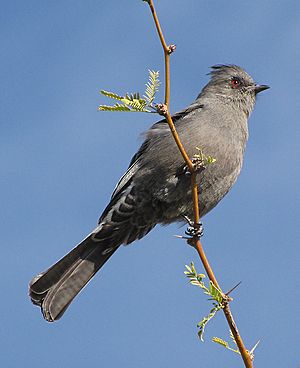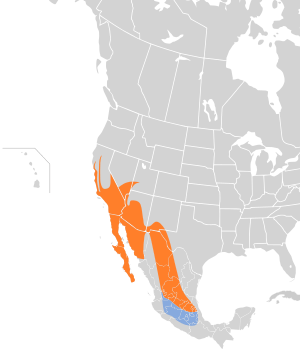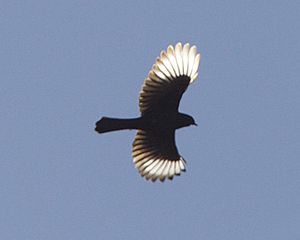Phainopepla facts for kids
Quick facts for kids Phainopepla |
|
|---|---|
 |
|
| Male | |
 |
|
| Female in California, USA | |
| Conservation status | |
| Scientific classification | |
| Genus: |
Phainopepla
|
| Species: |
nitens
|
 |
|
The phainopepla (pronounced fay-no-PEP-la) is also called the northern phainopepla. Its scientific name is Phainopepla nitens. This bird is the most northern member of a bird family called silky flycatchers (Ptiliogonatidae). Most birds in this family live in warmer, tropical parts of Central America. The name "phainopepla" comes from a Greek phrase that means "shining robe." This name describes the male bird's shiny feathers.
Contents
What Does the Phainopepla Look Like?
The phainopepla is a very noticeable bird. It is about 16 to 20 centimeters (6 to 8 inches) long. It has a clear crest (a tuft of feathers on its head) and a long tail. When it sits on a branch, it stands up straight. Its beak is short and thin.
The male phainopepla is a shiny black color. When it flies, you can see a white patch on its wings. The female phainopepla is a plain gray color. She has a lighter gray patch on her wings. Both male and female phainopeplas have red eyes. The red eyes are easier to see on the female bird.
Where Do Phainopeplas Live?
Phainopeplas live in many places. They can be found as far north as central California and southern Utah. They also live south into central Mexico. They prefer hot areas, like desert oases. You can often see them in the deserts of Arizona, southern Nevada, and southern California. They also live on the Baja Peninsula in Mexico.
Some phainopeplas travel very far. One bird was seen in Brampton, Ontario, Canada, in 2009! This shows how far these birds can sometimes fly.
What Do Phainopeplas Eat?
Phainopeplas eat berries, small insects, and other fruits and vegetables. They have a special way to eat berries. Their gizzard (a part of their stomach) can remove the berry skins. It packs the skins separately from the fruit. This helps them digest the fruit more easily. The phainopepla is the only bird known to do this! They especially love the fruit of the desert mistletoe.
Phainopepla Life Cycle and Reproduction
Phainopeplas build their nests in the spring. Their eggs are gray or pink and have speckles. Both the male and female birds take turns sitting on the eggs. This is called incubation, and it lasts for about fifteen days. After the eggs hatch, the parents will care for the young birds for up to nineteen more days.
Phainopepla Songs and Sounds
Phainopeplas are good at imitating other birds. They have been heard copying the calls of at least twelve different bird species. For example, they can sound like a red-tailed hawk or a northern flicker.
See also
 In Spanish: Capulinero negro para niños
In Spanish: Capulinero negro para niños



